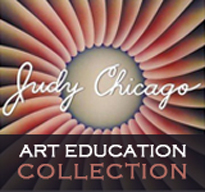Chicago/Woodman Teaching Methodology:
Participatory Art Pedagogy Informed by Feminist Principles
The list above and animation on the website presents the Chicago/Woodman Participatory Art Pedagogy. The term participatory used to describe the teaching methodology is rooted in democratic practices that provide a space for each to speak and a community support structure in which different views are encouraged to be expressed and argued without retaliation from the group. The animation symbolizes the methodology. It is an organic process brought to full-bloom by the people participating in the art project. The coming together into a circle is both symbolic of the group generating energy to sustain and support the creation of powerful artworks, and a literal approach to including and listening to all who comprise the circle of the group.

Two ETF participants, Denise Duffield and Snezana Petrovic, present their puppet performance concept along with media and format plans to the performance facilitator, Gayle Fekete, and to the performance group, and to Judy Chicago and Donald Woodman on December 5, 2003.
PREPARATION: The sharing of readings, research, and self ignites the power of the art created by the group. The dynamics of the group motivates the individual to search deeply and set significant artmaking goals.
PROCESS: The process continues with discussions between facilitator and participants about individual choices of work mode, media, and format. A difficult stage is to change the ideal to the real by navigating limits of time, space, and resources. It involves transformation of personal experience and researched content into a tangible visual form. A support structure develops from meeting these challenges together and sharing individual experiences and goals.
ARTMAKING: The process would not work if the participants were not selected for their commitment to discovery. Artmaking moves from material samples, sketches, and models to creating the artforms. The facilitator has the difficult task of providing both support and guidance. The participant often struggles at this stage to accept some of the challenges that arise from the content-based critiques. Judy Chicago suggests that the problem for some of the artists is to create something with a clear vision. The issue of audience is essential to consider in order to create art that sustains viewers’ attention to the work and the issues informed by it. The audience response is one element in the evaluation of the worth of the work.

(left to right): Donald Woodman, Julie Kornblum, and Judy Chicago discuss Julie’s tapestry design. Rachel Grynberg shows a small boat form to Judy Chicago as she describes her intentions for an installation. Hilda Piedeahita is asked by Judy Chicago to explain the meaning behind her model of a proposed installation. Photographs taken by Karen Keifer-Boyd on Oct. 20, 2003 at an ETF installation group session.
Read more:
1/ Overview
2/ Chicago/Woodman Teaching Methodology
3/ Relationship of Chicago/Woodman’s Participatory Art Pedagogy to Other Forms of Feminist Art Pedagogies
4/ Relationship of the Participatory Art Pedagogy to Other Art Teaching Approaches
5/ References & Copyrights


Leave a Reply
You must be logged in to post a comment.